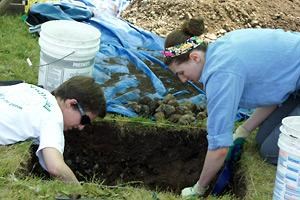While an archaeological field school has wrapped up its excavations, the work of piecing together the history of the area and its ancient inhabitants continues.
Tla’amin (Sliammon) First Nation and Simon Fraser University (SFU) entered into a partnership in 2007 and launched the Tla’amin-SFU Archaeology and Heritage Stewardship Program. While Tla’amin members have extensive oral knowledge of their history, the area was largely unexplored from an archaeological perspective. The project brings together oral traditions with information from archaeological field work conducted in the summer and archival investigations.
Dana Lepofsky, a professor of archaeology at SFU and a project director, said that over the years, the program has evolved from a field school to having more of a focus on ethnohistory. Lepofsky said next year, students would be conducting interviews only.
“That means we’re really diving into the historic archives and talking to people,” she said. “It’s actually been really good, really a privilege and really amazing. It helps fill in that later part of history and give it context as well. Because of the more recent destruction of the landscape through logging, the late part of the archaeological record is destroyed. It’s really nice when memories tap into that pool of knowledge and we can combine that with archaeology.”
In the initial years of the project, one of the areas archaeologists studied was Scuttle Bay (Kleh Kwa Num). Knowledge from Tla’amin elders indicated the bay was used to gather and process foods such as herring and Saskatoon berries, a place to take refuge during conflict and a place to live. Excavations at Scuttle Bay in 2008 and 2009 yielded stone and bone artifacts, the remains of plant and animal foods, indications of numerous longhouses and a petroglyph (pecked boulder).
Elders’ memories of the area went back to 1910, Lepofsky said. “Then the archaeology picked up right there and in that case went back 3,000 years,” she said.
People have lived in the region for as long as the land was available to live on, Lepofsky said. “As soon as the sea level stabilized after the ice age, which is something like 8,000 years ago, we start seeing archaeological sites from that time period,” she said. “We know very little about that early time period, because those sites are largely destroyed and there weren’t very many of them, probably.”
People settled in the best places early on, such as Grace Harbour, said Lepofsky, which has been dated as 7,000 years old. Other places, such as Cochrane Bay and Bliss Landing, were occupied early on because they were protected from the elements, have good views and provide access to a whole range of resources. There is evidence of larger and more permanent settlements dating from around 3,000 years ago. Generally, people seem to have been living in some kind of an equivalent to a longhouse, said Lepofsky, but not always. “We find all kinds of variations on houses that suggest pretty interesting social relations,” she said. “At Cochrane Bay, we have enormous in-ground houses that look like someone was marrying in with northern peoples. We don’t know, but there were certainly some connections with the north.”
They’ve also found interesting connections about trade relations, how they shift through time, and people’s expressions of themselves, Lepofsky said. “I think there are all kinds of interesting social relations that are embedded in the archaeological record and tell a more interesting story than just more people through time,” she said.
Another interesting aspect of the work is that the whole mainland has been landscaped and all the flat land has been created, Lepofsky added. “The logging roads and early settler homes are all built on flats that were created by the ancient people,” she said.
Another result has been the enormous amount of management and use of the intertidal zone. In a fly-over, the archaeologists found over 60 sites that were unknown. “We’re finding, intact, very complicated, highly engineered fish traps and clam gardens,” Lepofsky said. “These are areas that have been cleared to maximize clam growth and also to trap fish.”
While the field school may have ended for now, the partnership continues. More information, including student papers, can be found on the Tla’amin archaeology website.



